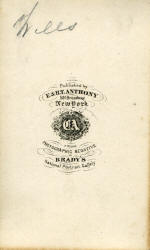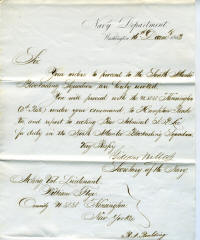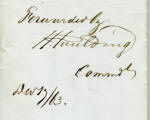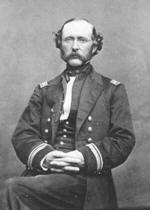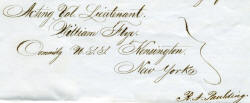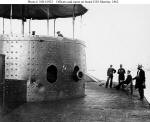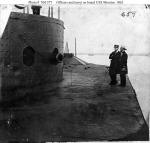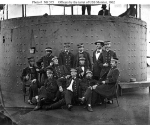CDV of Gideon Wells
Secretary of the U. S. Navy during the Civil War
Brady CDV and Signed Civil War Letter By Gideon Welles 16 Dec 1863. Also Signed By William Flye & Admiral Hiram Paulding
Gideon Welles (July 1, 1802 – February 11, 1878) was the United States Secretary of the Navy from 1861 to 1869. His buildup of the Navy to successfully execute blockades of Southern ports was a key component of Northern victory of the Civil War. Welles was also instrumental in the Navy's creation of the Medal of Honor.
Gideon Welles, the son of Samuel Welles and Ann Hale, was born on July 1, 1802 in Glastonbury, Connecticut. His father was a shipping merchant and fervent Jeffersonian; he was a member of the Convention which formed the first state Connecticut Constitution in 1818 that abolished the colonial charter and officially severed the political ties to England.
He was educated at the Episcopal Academy at Cheshire, Connecticut, and earned a degree at the American Literary, Scientific, and Military Academy at Norwich, Vt. (later Norwich University). He became a lawyer through the then-common practice of reading the law, but soon shifted to journalism and became the founder and editor of the Hartford Times in 1826. After successfully gaining admission, from 1827–1835, he participated in the Connecticut House of Representatives as a Democrat. Following his service in the Connecticut General Assembly, he served in various posts, including State Controller of Public Accounts in 1835, Postmaster of Hartford (1836–41), and Chief of the Bureau of Provisions and Clothing for the Navy (1846–49)
Mainly because of his strong anti-slavery views, Welles shifted allegiance in 1854 to the newly-established Republican Party, and founded a newspaper in 1856 (the Hartford Evening Press) that would espouse Republican ideals for decades thereafter. Welles' strong support of Abraham Lincoln in 1860 made him the logical candidate from New England for Lincoln's cabinet, and in March 1861 Lincoln named Welles his Secretary of the Navy.
Welles found the Naval Department in disarray, with Southern officers resigning en masse. His first major action was to dispatch the Navy's most powerful warship, the USS Powhatan, to relieve Fort Sumter. Unfortunately, Lincoln had simultaneously ordered the Powhatan to both Fort Sumter and Pensacola, Florida, ruining whatever chance Major Robert Anderson had of withstanding the assault. Several weeks later, when William H. Seward argued for a blockade of Southern ports, Welles argued vociferously against the action but was eventually overruled by Lincoln. Despite his misgivings, Welles' efforts to rebuild the Navy and implement the blockade proved extraordinarily effective. From 76 ships and 7600 sailors in 1861, by 1865 the Navy expanded almost tenfold. His implementation of the Naval portion of the Anaconda Plan strongly weakened the Confederacy's ability to finance the war through limiting the cotton trade, and while never completely effective in sealing off all 3,500 miles of Southern coastline it was a major contribution towards Northern victory. Lincoln nicknamed Welles his "Neptune".
Despite his successes, Welles was never at ease in the United States Cabinet. His anti-English sentiments caused him to clash with William H. Seward, Secretary of State, and Welles's conservative stances led to arguments with Salmon P. Chase and Edwin M. Stanton, the Secretaries of the Treasury and of War, respectively.
After Lincoln's assassination Welles was retained by President Andrew Johnson as Secretary of the Navy.
Welles ultimately left the Cabinet on March 3, 1869, having returned to the Democratic Party after disagreeing with Andrew Johnson's reconstruction policies but supporting him during his impeachment trial.(From Wikipedia)
Navy Department Letter signed by Gideon Wells
Navy Department letterhead with embossed eagle crest on top left side. The heavy 8 3/4 x 15 5/8 paper has 'chain' marks and the ink is browning.
The letter reads as follows:
Navy Department Washington 16th December 1863
Sir, Your orders to proceed to the South Atlantic Blockading Squadron are hereby revoked.
You will proceed with the U.S.S. Kensington (3rd rate) under your command to Hampton Roads Va, and report to acting Rear Admiral S. P. Lee for duty in the North Atlantic Blockading Squadron.
Very Resp'y Gideon Welles Secretary of the Navy
Acting Vol Lt. William Flye Comm'dg U S S Kensington New York
Letter is also signed by Lt. William Flye of the Monitor and Lexington fame. Signed on the back by Admiral Hiram Paulding.
Hiram Paulding's signature on front of the folded letter above
Rear Admiral Hiram Paulding 1797-1878. He served in the War of 1812 as well as the Civil War. The USS Paulding (DD-22) was named in his honor ! In 1861 Paulding was appointed by President Abraham Lincoln to assist in building up a wartime fleet. He then became Commandant of the New York Navy Yard in 1864-1865. After the war Paulding served as Governor.
Capt. William Flye: Acting Volunteer Lieutenant of the USS Monitor
Captain William Flye, born 25 Oct 1814, died 12 Jun 1898, His service on the Monitor is dated 1862, but the photo may be from earlier in his life. Graduated Bowdoin College 1835, Prof. of Math 1841 - 1857 USN; and Lt. Commander 1861 - 1866 USN. See much more on Wm. Flye
Signature of William Flye
View on deck looking forward on the starboard side, while the ship was in the James River, Virginia, 9 July 1862. The turret, with the muzzle of one of Monitor's two XI-inch Dahlgren smoothbore guns showing, is at left. Note dents in turret armor from hits by Confederate heavy guns and crewmembers atop the turret.
Officers at right are (left to right): Third Assistant Engineer Robinson W. Hands, Acting Master Louis N. Stodder, Second Assistant Engineer Albert B. Campbell (seated) and Acting Volunteer Lieutenant William Flye (with binoculars).U.S. Naval Historical Center Photograph
USS Monitor (1862)
Officers standing at right are Second Assistant Engineer Albert B. Campbell (with arms folded) and Acting Volunteer Lieutenant William Flye (with binoculars).
U.S. Naval Historical Center Photograph
USS Monitor (1862)
Officers on deck of Monitor's gun turret, while the ship was in the James River, Virginia, on 9 July 1862.
They are, Standing, top row, left to right:
Master's Mate George Frederickson;
Third Assistant Engineer Mark Trueman Sunstrom;
Lieutenant Samuel Dana Greene;
Lieutenant L. Howard Newman (Executive Officer of USS Galena) and First Assistant Engineer Isaac Newton.
Seated in chairs, middle row, left to right:
Acting Master Louis N. Stodder;
Acting Assistant Paymaster William F. Keeler;
Acting Volunteer Lieutenant William Flye; and
Acting Assistant Surgeon Daniel C. Logue.
Seated on deck in front, left to right:
Third Assistant Engineer Robinson W. Hands;
Second Assistant Engineer Albert B. Campbell; and
Acting Master E.V. Gager.U.S. Naval Historical Center Photograph

